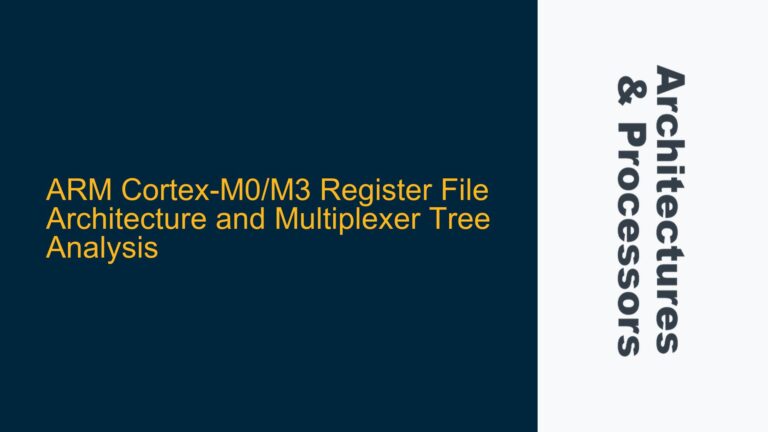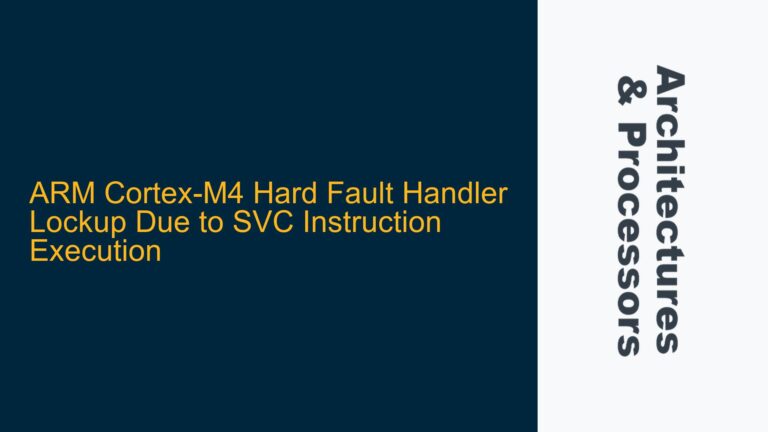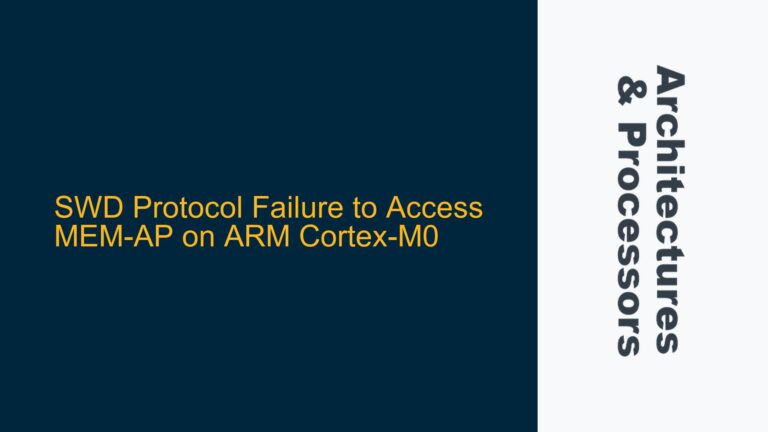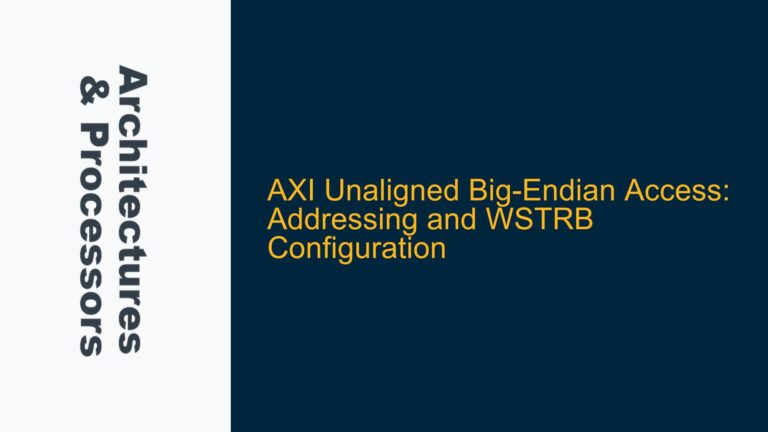ARM Cortex-M4 to Cortex-R5F: Exception Model and Interrupt Handling Differences
The migration from ARM Cortex-M4 to Cortex-R5F involves significant changes in the exception model and interrupt handling mechanisms. The Cortex-M4 utilizes the Nested Vectored Interrupt Controller (NVIC), which is tightly integrated with the processor core and provides low-latency interrupt handling. In contrast, the Cortex-R5F employs a Vector Interrupt Controller (VIC), which is more complex and offers additional features such as prioritization and masking of interrupts.
The NVIC in Cortex-M4 supports up to 240 interrupts, each with a programmable priority level. It also includes features like tail-chaining, which reduces the overhead of interrupt stacking and unstacking. The NVIC is designed for deterministic interrupt handling, making it suitable for real-time applications.
On the other hand, the VIC in Cortex-R5F provides a more flexible interrupt handling mechanism. It supports a larger number of interrupts and allows for more complex interrupt prioritization schemes. The VIC also includes features like interrupt nesting and vectoring, which can improve the responsiveness of the system. However, the increased flexibility comes at the cost of higher complexity in software implementation.
When migrating from Cortex-M4 to Cortex-R5F, developers need to update their interrupt handling code to accommodate the differences between NVIC and VIC. This includes modifying the interrupt service routines (ISRs) to use the new VIC APIs, updating the interrupt priority settings, and ensuring that the interrupt vectors are correctly configured in the memory map.
Additionally, the exception model in Cortex-R5F is more complex than in Cortex-M4. The Cortex-R5F supports multiple exception levels, including IRQ, FIQ, and Abort modes, each with its own set of registers and stack pointers. This allows for more sophisticated exception handling, but also requires careful management of the exception stack and context switching.
Developers must also consider the impact of cache memory on interrupt handling. The Cortex-R5F includes a cache memory system, which can affect the timing and predictability of interrupt responses. Proper cache management techniques, such as cache invalidation and flushing, must be implemented to ensure that interrupt handling remains deterministic.
Memory Map and Startup Code Adjustments for Cortex-R5F
The memory map and startup code for Cortex-R5F differ significantly from those of Cortex-M4, necessitating careful adaptation during migration. The Cortex-M4 typically uses a flat memory map with a single address space for code, data, and peripherals. In contrast, the Cortex-R5F employs a more complex memory map, often including multiple memory regions with different attributes, such as cacheable, non-cacheable, and device memory.
The startup code for Cortex-M4 is relatively straightforward, involving the initialization of the stack pointer, vector table, and basic system peripherals. However, the startup code for Cortex-R5F must account for the more complex memory map and additional features like cache and memory protection.
One of the first steps in adapting the startup code is to configure the memory protection unit (MPU) in Cortex-R5F. The MPU allows developers to define memory regions with specific access permissions and attributes. Proper configuration of the MPU is crucial for ensuring system security and stability. This involves setting up memory regions for code, data, and peripherals, and assigning the appropriate access permissions and cache attributes.
The vector table in Cortex-R5F also requires attention. Unlike Cortex-M4, where the vector table is located at a fixed address, the Cortex-R5F allows for more flexibility in the placement of the vector table. Developers must ensure that the vector table is correctly aligned and mapped in the memory map, and that the exception vectors are properly initialized.
Another important aspect of the startup code is the initialization of the cache memory system. The Cortex-R5F includes both instruction and data caches, which must be enabled and configured during startup. This involves setting up cache attributes for different memory regions, enabling the cache, and performing any necessary cache maintenance operations.
Finally, the startup code must initialize any additional peripherals and system components that are specific to Cortex-R5F. This may include configuring the system timer, enabling interrupts, and setting up any required system clocks.
Systick Timer, Cache, and FPU Considerations in Cortex-R5F
The Systick timer, cache memory, and floating-point unit (FPU) in Cortex-R5F introduce additional considerations that must be addressed during migration from Cortex-M4. The Systick timer in Cortex-R5F is similar to that in Cortex-M4, but there are some differences in its configuration and usage.
In Cortex-M4, the Systick timer is often used for generating periodic interrupts and implementing time delays. The configuration of the Systick timer in Cortex-M4 is straightforward, involving the setting of the reload value and enabling the timer. However, in Cortex-R5F, the Systick timer may require additional configuration steps, such as setting the clock source and configuring the interrupt priority.
The cache memory system in Cortex-R5F is another area that requires attention. The Cortex-R5F includes both instruction and data caches, which can significantly improve system performance. However, the use of cache memory also introduces challenges in terms of cache coherency and consistency.
Developers must ensure that the cache is properly configured and managed to avoid issues such as stale data and cache thrashing. This involves setting up cache attributes for different memory regions, enabling the cache, and performing cache maintenance operations as needed. Proper cache management is particularly important in systems that use DMA (Direct Memory Access) or shared memory between multiple cores.
The FPU in Cortex-R5F is another feature that requires consideration during migration. The Cortex-R5F includes a dedicated FPU, which supports single-precision and double-precision floating-point operations. This is in contrast to Cortex-M4, which may or may not include an FPU, depending on the specific variant.
If the existing code on Cortex-M4 uses floating-point operations, it may need to be modified to take advantage of the FPU in Cortex-R5F. This includes ensuring that the FPU is properly enabled and configured, and that the floating-point operations are correctly optimized for the Cortex-R5F architecture.
In addition to these considerations, developers must also be aware of the impact of cache and FPU on system performance and power consumption. Proper configuration and management of these features can help to optimize system performance and reduce power consumption, which is particularly important in embedded systems.
In conclusion, migrating from Cortex-M4 to Cortex-R5F involves several key differences in exception handling, memory map, startup code, Systick timer, cache memory, and FPU. Developers must carefully adapt their software to account for these differences, ensuring that the system remains stable, secure, and performant. By following the guidelines outlined in this post, developers can successfully navigate the migration process and take full advantage of the features offered by Cortex-R5F.






